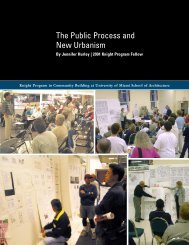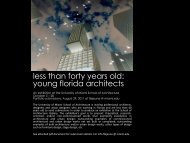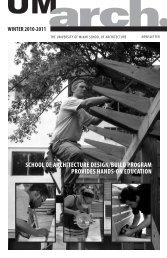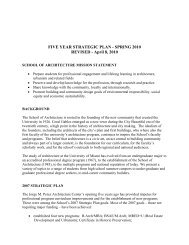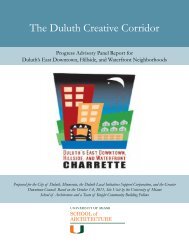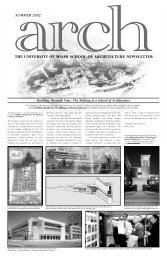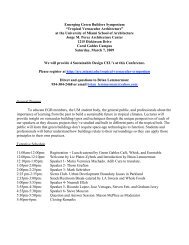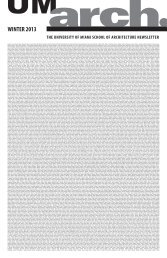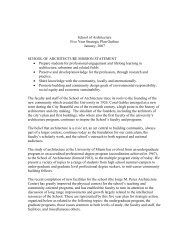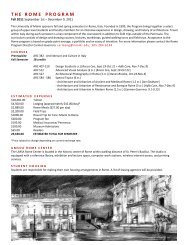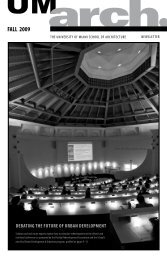New Plazas for New Mexico: A Back to the Future Approach for ...
New Plazas for New Mexico: A Back to the Future Approach for ...
New Plazas for New Mexico: A Back to the Future Approach for ...
You also want an ePaper? Increase the reach of your titles
YUMPU automatically turns print PDFs into web optimized ePapers that Google loves.
<strong>New</strong> <strong>Plazas</strong> <strong>for</strong> <strong>New</strong> <strong>Mexico</strong>:<br />
A <strong>Back</strong> <strong>to</strong> <strong>the</strong> <strong>Future</strong> <strong>Approach</strong><br />
<strong>for</strong> Revitalizing Public Spaces<br />
By Ken Hughes, AICP | 2001 Knight Program Fellow<br />
Knight Program in Community Building at University of Miami School of Architecture
Great cities, big and small, are made up not just of great<br />
buildings, but of wonderful places — public plazas, parks — all<br />
<strong>the</strong> places in which we conduct our public lives <strong>to</strong>ge<strong>the</strong>r. We need<br />
<strong>the</strong>se places <strong>to</strong> sustain us, <strong>to</strong> uplift us.<br />
Today, we live compartmentalized lives — we go <strong>to</strong> work,<br />
we come home. Technology has cut back <strong>the</strong> need <strong>for</strong> much<br />
face-<strong>to</strong>-face interaction. Our cities must offer beautiful public<br />
places that bring us <strong>to</strong>ge<strong>the</strong>r again. The notion of people being<br />
down<strong>to</strong>wn is about people being <strong>to</strong>ge<strong>the</strong>r, not in virtual space,<br />
but in real space. Good urban design is not just about making<br />
things pretty <strong>to</strong> make architects happy. It’s about providing an<br />
atmosphere that makes <strong>the</strong> daily rituals of life better, easier,<br />
perhaps even inspiring. We must continue <strong>to</strong> foster urban<br />
development that creates an atmosphere in which people enjoy<br />
<strong>the</strong> way <strong>the</strong>y live.<br />
— Richard Rosan (President, Urban Land Institute),<br />
“A Celebration Of America’s Cities,” September 21, 2001
1<br />
Contents<br />
2<br />
Abstract<br />
4<br />
Acknowledgements<br />
5<br />
Full Report<br />
30<br />
Appendices<br />
Cover<br />
The 291st Santa Fe Fiesta (September 2003), held in Sante Fe Plaza, is <strong>the</strong> oldest continually celebrated community<br />
festival in <strong>the</strong> United States.
2<br />
<strong>New</strong> <strong>Plazas</strong> <strong>for</strong> <strong>New</strong> <strong>Mexico</strong>: A <strong>Back</strong> <strong>to</strong> <strong>the</strong> <strong>Future</strong><br />
<strong>Approach</strong> <strong>for</strong> Revitalizing Public Spaces<br />
Ken Hughes, AICP | 2001 Knight Program Fellow<br />
Bio<br />
Ken Hughes is chief planner<br />
<strong>for</strong> State of <strong>New</strong> <strong>Mexico</strong>’s<br />
Department of Finance and<br />
Administration in Sante Fe,<br />
<strong>New</strong> <strong>Mexico</strong>.<br />
Abstract<br />
• How can <strong>New</strong> <strong>Mexico</strong> communities resurrect plazas <strong>to</strong> renew pride and<br />
revitalize local economies while honoring local culture<br />
• How can plazas help trans<strong>for</strong>m communities in<strong>to</strong> more livable places <strong>for</strong><br />
people of all ages<br />
• What is a plaza as a public space type Where should it go How should<br />
it be repaired <strong>to</strong> make it happen again How can it honor both daily and<br />
ritual uses<br />
These were <strong>the</strong> primary questions explored both by <strong>the</strong> author’s Knight<br />
Fellowship research and during <strong>the</strong> “<strong>New</strong> <strong>Plazas</strong> <strong>for</strong> <strong>New</strong> <strong>Mexico</strong>” symposium<br />
held in Santa Fe, <strong>New</strong> <strong>Mexico</strong>, on Oc<strong>to</strong>ber 13, 2001, where speakers explained <strong>the</strong><br />
origins of plazas in <strong>New</strong> <strong>Mexico</strong> and offered paths <strong>to</strong>ward revitalization.<br />
When attempting plaza revitalization, several guidelines are worth heeding:<br />
01. Ask <strong>the</strong> <strong>to</strong>wn what it needs. Out of active listening <strong>to</strong> residents, design<br />
in neighborliness; stir up <strong>the</strong> vision. This creates settings with a deeper<br />
sense of meaning.<br />
02. Observe current uses. Analyze what is celebrated, protested, commemorated,<br />
mourned; revitalize plazas <strong>to</strong> be relevant <strong>for</strong> twenty-first century uses.<br />
03. Keep it local. Root plaza uses in culture, milieu, and his<strong>to</strong>ry; avoid trendy<br />
<strong>to</strong>urist attractions; focus on small changes, not <strong>the</strong> grand slam.<br />
04. Attend <strong>to</strong> users’ needs and rights <strong>to</strong> create a plaza full of incidental<br />
civilities; avoid changes (uses) that over time make <strong>the</strong> heart go yonder.<br />
In o<strong>the</strong>r words, love a place without being dangerous <strong>to</strong> it.<br />
05. Review how <strong>the</strong> Laws of <strong>the</strong> Indies have lasted and endured. Keep <strong>the</strong><br />
plaza flexible enough <strong>for</strong> different events.<br />
06. Root in local climate, his<strong>to</strong>ry, <strong>to</strong>pography, and building practice.<br />
Ensure that <strong>the</strong> plaza is <strong>for</strong> people of all ages.<br />
07. To fund <strong>the</strong> revitalization, raise awareness, interest, and excitement.<br />
Add quality design. The funds will follow.
3<br />
08. Design in meeting and mingling; provide a rich mix of uses, interests,<br />
and ages. Anchor surrounding streets.<br />
09. Frame <strong>the</strong> plaza with buildings <strong>to</strong> avoid physical gaps; create synergy<br />
between <strong>the</strong> plaza and its buildings.<br />
10. Design in freedom of activities, manage out insecurity; manage <strong>the</strong> feel<br />
of <strong>the</strong> plaza <strong>to</strong> sustain it <strong>for</strong> <strong>the</strong> long haul.<br />
The plaza can be one of <strong>the</strong> most significant <strong>to</strong>ols <strong>for</strong> social and economic<br />
revitalization. Its flexibility is almost without peer in <strong>the</strong> urban setting: It can host<br />
ceremonies and concerts; calm traffic and noise; accommodate a farmers’<br />
market, a national retailer, and artisan vendors with equal ease; allow restaurants<br />
and street vendors <strong>to</strong> operate side by side; build relationships among generations<br />
and strangers; and allow citizens <strong>to</strong> learn via web access at a bus s<strong>to</strong>p.<br />
The plaza <strong>for</strong>m can combat <strong>the</strong> bland and <strong>the</strong> banal environments that<br />
suburbia has woven in<strong>to</strong> <strong>the</strong> American lifestyle. It can deliver us from <strong>the</strong> calamity<br />
of modernity and res<strong>to</strong>re meaning <strong>to</strong> our public realm. It is a centuries-old<br />
answer <strong>to</strong> our ongoing question: How do we want <strong>to</strong> live
4<br />
Acknowledgements<br />
The author wishes <strong>to</strong> thank Chuck Bohl and <strong>the</strong> “fellow” fellows at <strong>the</strong> Knight<br />
Program in Community Building; local government division direc<strong>to</strong>r Jeff Condrey<br />
and bureau chief Dave Hanna; and his wife, Ellen, <strong>for</strong> <strong>the</strong>ir unstinting support.<br />
Thanks also <strong>to</strong> Chris Callot, Mark Childs, Stefanos Polyzoides, and Chris Wilson<br />
whose University of <strong>New</strong> <strong>Mexico</strong> charrette on <strong>the</strong> Doña Ana plaza was most inspiring;<br />
<strong>to</strong> <strong>the</strong> <strong>New</strong> <strong>Mexico</strong> APA and Harrison Higgins <strong>for</strong> receipt of a national planning<br />
award in recognition of <strong>the</strong> state’s plazas; <strong>to</strong> Tom Lea<strong>the</strong>rwood <strong>for</strong> getting me in<strong>to</strong><br />
and through this; and <strong>to</strong> all <strong>the</strong> communities in <strong>New</strong> <strong>Mexico</strong> that I am<br />
privileged <strong>to</strong> support.
5<br />
<strong>New</strong> <strong>Plazas</strong> <strong>for</strong> <strong>New</strong> <strong>Mexico</strong>: A <strong>Back</strong> <strong>to</strong> <strong>the</strong> <strong>Future</strong><br />
<strong>Approach</strong> <strong>for</strong> Revitalizing Public Spaces<br />
Ken Hughes, AICP | 2001 Knight Program Fellow<br />
Image<br />
From Mesa del Sol plan by<br />
Tom Lea<strong>the</strong>rwood, <strong>New</strong> <strong>Mexico</strong><br />
State Land Office—<strong>the</strong> premier<br />
example of a <strong>New</strong> Urbanist<br />
planned development honoring<br />
Laws of <strong>the</strong> Indies principles.<br />
Illustration courtesy George<br />
Lawrence, Sketchbook Studio,<br />
Santa Fe.<br />
Introduction<br />
Using as inspiration <strong>the</strong> sixteenth century Laws of <strong>the</strong> Indies and <strong>the</strong> twenty-first<br />
century Charter of <strong>the</strong> <strong>New</strong> Urbanism, as well as what works in public spaces around<br />
<strong>the</strong> world, this paper offers ideas <strong>for</strong> revitalizing <strong>New</strong> <strong>Mexico</strong>’s existing plazas, and<br />
<strong>for</strong> planning and designing new plazas.<br />
The Laws of <strong>the</strong> Indies were compiled in 1573 by King Phillip II of Spain <strong>to</strong><br />
instruct <strong>the</strong> colonial communities <strong>to</strong> maintain friendly relations with natives, select<br />
a <strong>to</strong>wn site, and distribute <strong>to</strong>wn lots and farming lands <strong>to</strong> colonists. The laws prescribe<br />
a main plaza, <strong>to</strong> be located in <strong>the</strong> heart of <strong>the</strong> city:<br />
The main plaza is <strong>to</strong> be <strong>the</strong> starting point <strong>for</strong> <strong>the</strong> <strong>to</strong>wn. The plaza should be<br />
ei<strong>the</strong>r square or rectangular in shape; if <strong>the</strong> latter, <strong>the</strong> length should be at<br />
least 1 1 ⁄ 2 times <strong>the</strong> width.<br />
—Laws of <strong>the</strong> Indies Ordinance 112
6<br />
The physical planning effect of <strong>the</strong> Laws of <strong>the</strong> Indies’ plaza requirement on<br />
communities throughout Spain’s <strong>for</strong>mer colonies has been striking. More than eight<br />
hundred plazas anchored communities throughout Spain’s <strong>for</strong>mer colonies, from<br />
<strong>New</strong> Orleans <strong>to</strong> Havana, and from San Juan <strong>to</strong> Oaxaca. To this day, plazas offer<br />
visi<strong>to</strong>rs and residents a memorable, walkable experience. Indeed, a central plaza is an<br />
especially salient and dear characteristic of many communities throughout Spanish<br />
America, including <strong>New</strong> <strong>Mexico</strong>.<br />
Yet, like so many o<strong>the</strong>r sites of cities’ birthplaces—whe<strong>the</strong>r it be <strong>the</strong> railroad,<br />
<strong>for</strong>t, or waterfront—time, neglect, and abuse have all <strong>to</strong>o often taken <strong>the</strong>ir <strong>to</strong>ll on<br />
even <strong>the</strong> most wonderful <strong>New</strong> <strong>Mexico</strong> plaza, reducing it <strong>to</strong> a shadow of its past<br />
glory. 1 Un<strong>for</strong>tunately, despite <strong>the</strong> world-class status of plazas in Taos and Santa Fe,<br />
<strong>the</strong> vast majority of <strong>the</strong> seventy-plus plazas in <strong>the</strong> state are vestigial places, at least<br />
when compared <strong>to</strong> <strong>the</strong>ir original condition.<br />
The best public spaces are as unique as <strong>the</strong> best people, each with its own beauty,<br />
quirky personality, and regional accent. Their function is as “places in a community<br />
where people ga<strong>the</strong>r, where <strong>the</strong> life of <strong>the</strong> community blossoms,” according <strong>to</strong> Fred<br />
Kent, founder and president of Project <strong>for</strong> Public Spaces in <strong>New</strong> York City.<br />
The best commons are hubs of city life where <strong>the</strong>re’s always something going<br />
on. Activities are <strong>the</strong> “basic building blocks” of a commons, Kent says…<br />
Outdoor cafes provide a chance <strong>for</strong> people-watching, a favorite common-space<br />
activity. Public markets and o<strong>the</strong>r food-centered activities are good attractions,<br />
<strong>to</strong>o, and people love <strong>to</strong> sit near fountains and <strong>to</strong>uch <strong>the</strong> water…<br />
The great commons are also highly visible and easy <strong>to</strong> get <strong>to</strong>…This quality<br />
gives a community a convenient connection <strong>to</strong> its public places and makes it<br />
easy <strong>for</strong> people <strong>to</strong> circulate within <strong>the</strong>m…<br />
Safety and cleanliness are important…<br />
More important are character and charm. Is <strong>the</strong> space inviting and visually<br />
pleasing Are <strong>the</strong>re sculptures Shade trees Fountains Do people seem <strong>to</strong> be<br />
happy <strong>the</strong>re…<br />
Outstanding community commons provide focal points <strong>for</strong> public ga<strong>the</strong>rings<br />
and accommodate a variety of social activities, from concerts <strong>to</strong> art fairs <strong>to</strong> just<br />
plain conversations.<br />
1 “European colonizers were <strong>the</strong> first and most qualified city planners, who carried out <strong>the</strong> unique achievement of urbanizing<br />
an entire continent. An obvious result of this was <strong>the</strong> construction of many beautiful settlements, which were feasible,<br />
flexible and coherent. Perhaps this is due <strong>to</strong> <strong>the</strong> fact that <strong>the</strong> norms established by <strong>the</strong> Spanish Laws of <strong>the</strong> Indies<br />
were somewhat more flexible than <strong>the</strong> norms we have now, and that <strong>the</strong> Spanish urban planners of <strong>the</strong> 16th century<br />
were more sensible than those of <strong>the</strong> 20th century.” From Mario González Sedeño, “Havana: It Is and It Isn’t,”<br />
Arquitectura y Urbanismo 7 (1991).
HUGHES | REVITALIZING PUBLIC SPACES 7<br />
So what makes a vital, healthy community commons is ra<strong>the</strong>r simple, really:<br />
places <strong>to</strong> sit, plenty of shade, “<strong>to</strong>uchable” water, good food, and well-connected<br />
streets and sidewalks. But what a vital commons can offer a community is far<br />
from simple. A sense of identity. Belonging. Connectedness. Fun. Tradition.<br />
S<strong>to</strong>ries. Great public spaces are what memories of cities are made of. 2<br />
Prized <strong>Plazas</strong><br />
Some plazas make <strong>for</strong> better experiences than o<strong>the</strong>rs, especially ones thoughtfully<br />
designed and managed, without excessive parking or crass commercialism. Some<br />
examples of successful plazas in North America are discussed below.<br />
San An<strong>to</strong>nio<br />
Planning had its inception in San An<strong>to</strong>nio, with <strong>the</strong> first Spanish migration<br />
in<strong>to</strong> this region at <strong>the</strong> close of <strong>the</strong> seventeenth century. The Laws of <strong>the</strong> Indies<br />
prescribed <strong>to</strong>wn planning by dictating an elevated location, central plaza, street<br />
pattern, and sites <strong>for</strong> church, shops, government buildings, hospitals, and slaughterhouses.<br />
Today, this is most clearly seen in down<strong>to</strong>wn San An<strong>to</strong>nio, where <strong>the</strong><br />
Spanish Governor’s Palace borders Military Plaza and San Fernando Ca<strong>the</strong>dral fronts<br />
Main Plaza. The plazas were built <strong>to</strong> <strong>the</strong> specifications of <strong>the</strong> old laws and have<br />
persisted <strong>to</strong> <strong>the</strong> present in shape and <strong>for</strong>m. 3 Following <strong>the</strong> independence of <strong>Mexico</strong><br />
from Spain, San An<strong>to</strong>nio was controlled by <strong>the</strong> Laws and Decrees of Coahuila and<br />
Texas, which regulated <strong>to</strong>wn planning in <strong>the</strong> terri<strong>to</strong>ry and were similar <strong>to</strong> <strong>the</strong> Laws<br />
of <strong>the</strong> Indies. 4<br />
<strong>New</strong> Orleans<br />
Pierre Le Blond de la Tour designed <strong>the</strong> initial layout of <strong>the</strong> old his<strong>to</strong>ric district<br />
in 1722, using squares with measured streets running in a gridded symmetrical<br />
pattern around <strong>the</strong> main square, showing full use of <strong>the</strong> Laws of <strong>the</strong> Indies. In 1762,<br />
Louisiana fell under Spanish rule, yet even with <strong>the</strong> change in power <strong>the</strong>re was a<br />
consistent perceived need <strong>to</strong> preserve this core of <strong>the</strong> city.<br />
After <strong>the</strong> 1788 fire, <strong>the</strong> city was <strong>to</strong> be rebuilt in <strong>the</strong> French plan. Between 1803<br />
and 1835, <strong>New</strong> Orleans went back and <strong>for</strong>th between <strong>the</strong> hands of Spain, America,<br />
and France, as <strong>the</strong> land became a source of wealth and power. In 1803 <strong>the</strong> city was<br />
declared American, and has remained American ever since. The 1815 plan shows <strong>the</strong><br />
continuation of a planned gridded system of streets, struggling <strong>to</strong> be symmetrical<br />
along <strong>the</strong> water with new public squares locating centers of “suburbs.” 5<br />
2 Kari McGinnis, “Great Commons of <strong>the</strong> World,” Yes! (Summer 2001). Available online at<br />
www.futurenet.org/18Commons/mcginnis.htm.<br />
3 Handbook of Texas, online at www.tsha.utexas.edu/handbook/online/articles/print/UU/hyunw.html.<br />
4 San An<strong>to</strong>nio master plan, online at www.salsa.net/aiasa/sa-mastp.html.<br />
5 Gateway! <strong>New</strong> Orleans web site, online at www.gatewayno.com/VieuxCarre/vieuxcarre.html.
HUGHES | REVITALIZING PUBLIC SPACES 8<br />
Pho<strong>to</strong><br />
Las Vegas, <strong>New</strong> <strong>Mexico</strong>.<br />
<strong>Mexico</strong> City<br />
From its inception, <strong>the</strong> colonial city was laid out on a gridiron pattern as<br />
prescribed by <strong>the</strong> Spanish monarchy and later embodied in <strong>the</strong> Laws of <strong>the</strong> Indies.<br />
Urban life centered on <strong>the</strong> main plaza, which in <strong>Mexico</strong> City is called <strong>the</strong> Zocalo.<br />
All governmental offices, <strong>the</strong> National Palace, and <strong>the</strong> great majority of commercial<br />
activities are located within a short distance of <strong>the</strong> plaza. While this main plaza is<br />
enveloped in nine lanes of traffic on each side, walking in<strong>to</strong> <strong>the</strong> Zocalo is not an<br />
impossible task. It is not unusual <strong>to</strong> see Aztec dancers, many vendors selling food<br />
and drinks, concerts attended by thousands, and <strong>to</strong>urists lined up <strong>to</strong> view <strong>the</strong> world<br />
class treasures in <strong>the</strong> museums. 6<br />
Las Vegas, <strong>New</strong> <strong>Mexico</strong><br />
“In 1835, 29 individuals applied <strong>for</strong> and received <strong>the</strong> Las Vegas land grant<br />
from <strong>the</strong> Mexican government. The Alcalde (administrative justice) of nearby San<br />
Miguel del Vado accompanied <strong>the</strong> settlers <strong>to</strong> ‘<strong>the</strong> meadows,’ and, in Spanish manner<br />
according <strong>to</strong> <strong>the</strong> Laws of <strong>the</strong> Indies, <strong>the</strong>y laid out a large plaza and surrounding<br />
community.” The plaza served first as a parking lot <strong>for</strong> wagons and a staging ground<br />
<strong>for</strong> hangings (a windmill, erected in 1876, served briefly as a vigilante gallows).<br />
However, in 1880 <strong>the</strong> nature of <strong>the</strong> plaza began <strong>to</strong> change. That year, a bandstand<br />
surrounded by trees and a picket fence was built, replacing <strong>the</strong> windmill. “Today’s<br />
plaza, with its gazebo under a canopy of mature trees, reflects ef<strong>for</strong>ts of Las Vegas’<br />
first his<strong>to</strong>ric preservation movement… in <strong>the</strong> 1960s. The community continues <strong>to</strong><br />
show, through architecture and land use, <strong>the</strong> intersection of <strong>the</strong> cultures and people<br />
that settled Las Vegas.” 7<br />
6 Observations of Ellen Kemper, first-time <strong>Mexico</strong> City Zocalo visi<strong>to</strong>r, July 2003.<br />
7 “A Walking Tour of <strong>the</strong> Plaza and Bridge Street His<strong>to</strong>ric Districts,” Las Vegas Citizens’<br />
Committee <strong>for</strong> His<strong>to</strong>ric Preservation, 2001.
HUGHES | REVITALIZING PUBLIC SPACES 9<br />
Laws of <strong>the</strong> Indies Prescriptions and Effects<br />
1. Consistent standard <strong>for</strong> urban design<br />
• Size of plazas<br />
• Widths of streets<br />
• Gates and walls<br />
• Public buildings<br />
• Land subdivision in<strong>to</strong> lots<br />
2. Give consistency in urban pattern: block size, street widths<br />
• Specialized square<br />
• No walls around whole <strong>to</strong>wn, only <strong>the</strong> central buildings are <strong>for</strong>tified,<br />
especially <strong>the</strong> church<br />
• S<strong>to</strong>ne ramparts and cannon emplacements (San Juan).<br />
Walls only around Port Towns<br />
• European and native quarters in <strong>the</strong> city<br />
3. Caste barriers<br />
• Spanish aris<strong>to</strong>cracy lived in central part of <strong>to</strong>wn, on second floors<br />
of more public buildings<br />
• Creoles: mixed blood<br />
• Indians and blacks lived in native quarters: smaller blocks, narrower streets<br />
4. Municipal authority is limited<br />
• Unlike in Spain, <strong>the</strong> colonial <strong>to</strong>wn has little authority<br />
• Prices are regulated by <strong>the</strong> government at home<br />
• Guilds are regulated<br />
• Poor sanitary conditions and public conveniences<br />
5. Governance<br />
• The governor is <strong>the</strong> representative of <strong>the</strong> Spanish crown<br />
• The governor controls <strong>the</strong> militia<br />
• His taxing and spending power limited by <strong>the</strong> crown<br />
• Substantial city revenue comes from selling municipal positions<br />
• Municipal finance is in considerable disorder
HUGHES | REVITALIZING PUBLIC SPACES 10<br />
6. Crown intervention<br />
• Regional terri<strong>to</strong>ries are set up<br />
• Center takes over municipal functions: budgeting, street cleaning, water supply,<br />
hospitals and jails, markets, bakeries<br />
• Towns improve, cost is an all-inclusive state<br />
7. Capital cities are sites <strong>for</strong> viceroy’s seat, habitat of captains and generals<br />
• Monetary power<br />
• Church: spiritual power<br />
• Universities: sources of knowledge<br />
8. Trade<br />
• Restricted <strong>to</strong> <strong>the</strong> home country; colonies cannot trade with o<strong>the</strong>r European<br />
nations, nor with each o<strong>the</strong>r<br />
• Restrictive trade practices result in<br />
— Shortage of goods<br />
— Exorbitant prices<br />
— Depressed living standards<br />
— Smuggling and corruption<br />
• Agricultural production<br />
— Spain sends seeds, plants, breeding animals; it encouraged native crops<br />
such as corn, vanilla<br />
— Crops that might compete with Spain—such as grapes, olives, and silk—<br />
were not allowed<br />
— Huge land estates are <strong>for</strong>med<br />
— Inheritance is through primogeniture<br />
— Lands only partially cultivated with slave labor, not good exploitation of asset<br />
9. Industry<br />
• No manufacture that would compete with <strong>the</strong> home industry<br />
• Monopolistic middle man in <strong>the</strong> trade with Spain<br />
• Manufacture <strong>for</strong> local market only<br />
• Aris<strong>to</strong>crats did not understand industry<br />
• Indians did not acquire industrial skills
HUGHES | REVITALIZING PUBLIC SPACES 11<br />
10. Church<br />
• Has huge rural holdings<br />
• Acquires urban real estate<br />
• Wealth is nontaxable<br />
• Enter business and finance, charge high interest rates<br />
• Fewer civil buildings are created than churches<br />
11. City does not develop<br />
• Infrastructure poor: few roads, not allowed <strong>to</strong> work with o<strong>the</strong>r municipalities<br />
• Lack of industry<br />
• Lack of skilled labor<br />
• Lack of progressive agriculture<br />
• Cities not integrated with rural hinterland<br />
Source: A University of Michigan Hispanic Studies Program paper.
HUGHES | REVITALIZING PUBLIC SPACES 12<br />
Examples of <strong>New</strong> <strong>Mexico</strong> Communities With <strong>Plazas</strong><br />
Chimayo<br />
Here, <strong>the</strong> world-famous Santuario Chimayo, with healing powers ascribed <strong>to</strong> its<br />
soils, frames <strong>the</strong> village plaza.<br />
Mesilla<br />
All <strong>the</strong> ingredients of daily civility—church, books<strong>to</strong>re, restaurant, neighborhood<br />
bar—co-exist around <strong>the</strong> gazebo-adorned plaza.<br />
Monticello<br />
Monticello’s plaza was founded as a Mexican garrison in <strong>the</strong> early 1800s.<br />
Today it exudes rural charm like few o<strong>the</strong>rs still do. Stefanos Polyzoides, of <strong>the</strong><br />
<strong>New</strong> Urbanist firm Moule and Polyzoides, feels that this plaza deserves UNESCO<br />
world heritage designation.<br />
Doña Ana<br />
A rural hamlet, now part of <strong>the</strong> suburban area of Las Cruces (<strong>the</strong> state’s second-largest<br />
city), Doña Ana has benefited from a prize-wining charrette led by <strong>the</strong><br />
University of <strong>New</strong> <strong>Mexico</strong>’s Chris Wilson and <strong>the</strong> architecture firm of Moule &<br />
Polyzoides. With state funding, <strong>the</strong> plaza soon will be reborn <strong>to</strong> serve as a link<br />
among civic, religious, and his<strong>to</strong>ric sites.<br />
Las Vegas<br />
(see page 8)<br />
Albuquerque<br />
While not as well known as Santa Fe’s, <strong>the</strong> Old Town Plaza in <strong>the</strong> Duke City<br />
emanates charm and a real sense of place. The plaza area hosts many restaurants,<br />
shops, and a church.<br />
Santa Fe<br />
The world-renowned plaza hosts <strong>the</strong> nation’s longest-celebrated civic event,<br />
<strong>the</strong> 292-year-strong fiesta. These days, however, <strong>to</strong>urists outnumber locals <strong>for</strong> most<br />
of <strong>the</strong> year; <strong>the</strong> only exceptions are <strong>the</strong> fiesta, Independence Day, <strong>the</strong> December<br />
Las Posadas procession, and <strong>the</strong> May community day.<br />
Taos*<br />
Taos received a grant from <strong>the</strong> state in 2002 <strong>for</strong> a daylong workshop that<br />
attracted over one hundred Taosenos <strong>to</strong> talk out what it will take <strong>to</strong> make <strong>the</strong> plaza<br />
<strong>the</strong>irs once again. The workshop has already led <strong>to</strong> a new cinema, outdoor restaurant,<br />
and streetscaping of nearby alleys.
HUGHES | REVITALIZING PUBLIC SPACES 13<br />
Pho<strong>to</strong><br />
Mo<strong>to</strong>rcycle marriage,<br />
Old Town, Albuquerque.<br />
Española<br />
Ranchos de Taos<br />
La Union<br />
La Mesa<br />
Trampas<br />
San Jose<br />
Socorro*<br />
<strong>New</strong> <strong>Mexico</strong> Communities Seeking a Plaza<br />
Las Cruces*<br />
The state’s second-largest city seeks <strong>to</strong> reclaim its plaza (now <strong>the</strong> site of a driveup<br />
bank), and also <strong>to</strong> revitalize its moribund down<strong>to</strong>wn. It has attracted $700,000<br />
in state funding <strong>for</strong> <strong>the</strong> plaza and has enlisted <strong>the</strong> help of <strong>the</strong> planning firm Sites<br />
Southwest <strong>to</strong> draw up a down<strong>to</strong>wn revitalization plan.<br />
Los Ranchos de Albuquerque<br />
Los Ranchos’ design charrette in 2000 envisioned a plaza where <strong>the</strong>re now<br />
exists a strip mall and four-lane street. This led <strong>to</strong> adoption in 2003 of an awardwinning<br />
revision in <strong>the</strong> village’s zoning, <strong>to</strong> apply planning <strong>to</strong>ols such as transfer of<br />
development rights and density districts.<br />
*Communities planning and designing new/revitalized plazas in 2002.
HUGHES | REVITALIZING PUBLIC SPACES 14<br />
Gallup<br />
Founded as a railroad <strong>to</strong>wn with no plaza, Gallup is combining state, county,<br />
and city funds <strong>to</strong> carry out ano<strong>the</strong>r award-winning ef<strong>for</strong>t, a November 2002 plaza<br />
and down<strong>to</strong>wn redevelopment charrette, with <strong>the</strong> help of a team that is catalyzing<br />
<strong>the</strong> turnaround of down<strong>to</strong>wn Albuquerque.<br />
Hobbs<br />
Edgewood<br />
Dixon<br />
Bernalillo (founded 1598) <strong>to</strong> replace previous plaza<br />
Truth or Consequences (founded as Hot Springs)<br />
Ten Ways <strong>to</strong> Reclaim <strong>the</strong> Plaza<br />
To get back <strong>to</strong> <strong>the</strong> state in <strong>the</strong> community where its physical heart—<strong>the</strong> plaza—<br />
resonates as a prized place <strong>for</strong> all, follow <strong>the</strong>se ten steps. Where relevant <strong>the</strong> steps<br />
are accompanied by <strong>the</strong> applicable Laws of <strong>the</strong> Indies ordinance, paired with our era’s<br />
version, <strong>the</strong> Charter of <strong>the</strong> <strong>New</strong> Urbanism. 9 Key questions <strong>for</strong> public participation<br />
follow, suitable <strong>for</strong> charrettes or o<strong>the</strong>r community processes.<br />
1. Ask <strong>the</strong> <strong>to</strong>wn what it needs<br />
Public space authority Fred Kent urges trusting your own community residents,<br />
noting that “in any community <strong>the</strong>re are people who can provide an his<strong>to</strong>rical perspective,<br />
valuable insights in<strong>to</strong> how <strong>the</strong> area functions, and an understanding of <strong>the</strong><br />
critical issues and what is meaningful <strong>to</strong> people.” 10<br />
Public space design excels when it creates settings with a deeper sense of meaning.<br />
The surest way <strong>to</strong> identify what people need in a public place is simply <strong>to</strong> ask<br />
<strong>the</strong>m. An open house held in Santa Fe in September 2001 not only ga<strong>the</strong>red much<br />
citizen input on a rail yard plaza, it identified citizen talents that complemented <strong>the</strong><br />
aspirations. The vision statement developed at an Oc<strong>to</strong>ber 2001 Silver City workshop<br />
said that Silver City is “a <strong>to</strong>wn that seeks <strong>to</strong> preserve and foster our eclectic<br />
and artistic small <strong>to</strong>wn atmosphere while promoting our health and well-being.”<br />
A community will not go very far without a shared vision. Reminders of that vision<br />
are also important—restaurants in some Midwestern <strong>to</strong>wns have <strong>the</strong> community’s<br />
vision statement printed on <strong>the</strong>ir place mats; we would do well <strong>to</strong> emulate such<br />
vision-driven marketing ef<strong>for</strong>ts.<br />
9 <strong>New</strong> Urbanism is an urban design movement founded in 1993 that advocates re<strong>for</strong>m in real estate development with<br />
<strong>the</strong> aim of reducing sprawl by developing neighborhoods that are walkable, with a diverse range of housing and jobs.<br />
The Charter of <strong>the</strong> <strong>New</strong> Urbanism is <strong>the</strong> movement’s seminal document. The full text of <strong>the</strong> Charter is available online,<br />
on <strong>the</strong> website <strong>for</strong> <strong>the</strong> Congress <strong>for</strong> <strong>the</strong> <strong>New</strong> Urbanism, www.cnu.org.<br />
10 Fred Kent, How <strong>to</strong> Turn a Place Around: A Handbook <strong>for</strong> Creating Successful Public Spaces (Project <strong>for</strong> Public Spaces, 2000).
HUGHES | REVITALIZING PUBLIC SPACES 15<br />
The main plaza is <strong>to</strong> be <strong>the</strong> starting point <strong>for</strong> <strong>the</strong> <strong>to</strong>wn. The plaza should be ei<strong>the</strong>r<br />
square or rectangular in shape; if <strong>the</strong> latter, <strong>the</strong> length should be at least 1 1 ⁄ 2 times<br />
<strong>the</strong> width.<br />
—Laws of <strong>the</strong> Indies Ordinance 112<br />
Cities and <strong>to</strong>wns should be shaped by physically defined and universally accessible<br />
public spaces and community institutions; urban places should be framed by<br />
architecture and landscape design that celebrate local his<strong>to</strong>ry, climate, ecology,<br />
and building practice.<br />
—Charter of <strong>the</strong> <strong>New</strong> Urbanism<br />
Public participation questions:<br />
Lesson:<br />
• How many times have you been <strong>to</strong> your local plaza in <strong>the</strong> past year<br />
• What activities have you observed <strong>the</strong>re<br />
• What works best while you are <strong>the</strong>re<br />
• What do you feel is lacking<br />
• Get <strong>the</strong> “vision juices” flowing: They are needed <strong>to</strong> ga<strong>the</strong>r <strong>the</strong> planning,<br />
political, and financial will <strong>to</strong> make any large public works project happen.<br />
2. Observe current uses<br />
As a starting point, observe what is currently occurring in <strong>the</strong> plaza. Is <strong>the</strong> plaza<br />
not used much Underused Incorrectly used Are benches used not only <strong>for</strong> sitting,<br />
but also <strong>for</strong> sleeping, lovemaking, dancing<br />
A working plaza can serve as a place where children observe <strong>the</strong>ir parents safely<br />
interacting with strangers, a rarity in this country and in <strong>the</strong>se times. A plaza can<br />
meet this, as well o<strong>the</strong>r social needs of <strong>the</strong> community.<br />
A community can manage what happens in <strong>the</strong> plaza and how things are done.<br />
If pedestrian access is a priority and garish signs are not, say so. If political engagement—protests,<br />
candlelight vigils, and celebrations—resonates with your community,<br />
encourage residents <strong>to</strong> ga<strong>the</strong>r at <strong>the</strong> plaza. I witnessed this type of community<br />
choice in Telluride’s square in 1997, listening <strong>to</strong> a county commissioner recite<br />
Allen Ginsberg’s “Howl.”
HUGHES | REVITALIZING PUBLIC SPACES 16<br />
The size of <strong>the</strong> plaza should be proportional <strong>to</strong> <strong>the</strong> population, taking expected<br />
growth in<strong>to</strong> consideration; at a minimum, it should be 200’ x 300’; and maximum<br />
size should be 532’ x 800’. 400’ x 600’ is recommended as a good proportion.<br />
—Laws of <strong>the</strong> Indies Ordinance 113<br />
Streets and squares should be safe, com<strong>for</strong>table, and interesting <strong>to</strong> <strong>the</strong> pedestrian.<br />
Properly configured, <strong>the</strong>y encourage walking and enable neighbors <strong>to</strong> know each<br />
o<strong>the</strong>r and protect <strong>the</strong>ir communities.<br />
—Charter of <strong>the</strong> <strong>New</strong> Urbanism<br />
Public participation questions:<br />
Lesson:<br />
• How can <strong>New</strong> <strong>Mexico</strong> communities resurrect plazas <strong>to</strong> renew pride<br />
and revitalize local economies while honoring local culture<br />
• Why are plazas under challenge <strong>for</strong> meaning in <strong>New</strong> <strong>Mexico</strong><br />
• Can plazas be relevant <strong>for</strong> twenty-first century <strong>New</strong> <strong>Mexico</strong> communities<br />
• Choosing uses of <strong>the</strong> plaza are a function of who you are as a community.<br />
3. Keep it local<br />
For au<strong>the</strong>nticity, plazas must be rooted in <strong>the</strong> local culture, milieu, and his<strong>to</strong>ry.<br />
Thus, when new ideas and elements are introduced in<strong>to</strong> a plaza, its caretakers should<br />
ensure <strong>the</strong>ir compatibility with <strong>the</strong> original plaza design.<br />
The king of Spain controlled <strong>the</strong> design of sixteeenth century plazas. Today,<br />
many players affect community design: <strong>the</strong> highway department, <strong>the</strong> postal service,<br />
Wal-Mart, Texaco, and <strong>the</strong>ir local agents all have ideas about such issues as <strong>the</strong><br />
number of parking spaces, building size, and location. Too often, players whose<br />
agenda are detrimental <strong>to</strong> plaza fabric influence plaza design and functions in ways<br />
that are out of sync with community needs.<br />
“Keep it local” also means not going <strong>for</strong> <strong>the</strong> grand slam every time.<br />
“Plazafficianados” should choose a tangible improvement <strong>to</strong> make each year, no<br />
matter how small or seemingly insignificant—just as <strong>the</strong>re’s been incremental degradation,<br />
<strong>the</strong>re can be incremental success. For example, putting its focus on small,<br />
quaint pastel buildings and outdoor areas has trans<strong>for</strong>med Miami Beach from a slum<br />
in<strong>to</strong> a nine billion dollar real estate bonanza, with world-famous public spaces like<br />
Lincoln Road and Ocean Drive. Albuquerque rents out its plaza <strong>for</strong> events ranging<br />
from marriages <strong>to</strong> fiestas, a celebra<strong>to</strong>ry line item on that city’s budget. S<strong>to</strong>res and<br />
galleries surrounding Santa Fe’s plaza, whose rents sometimes <strong>to</strong>p $100/square<br />
foot, are <strong>the</strong> equivalent of a supermall’s square footage without <strong>the</strong> mall look.
HUGHES | REVITALIZING PUBLIC SPACES 17<br />
Pho<strong>to</strong><br />
Santa Fe Fiesta in Santa Fe Plaza,<br />
September 2003.<br />
The four principal streets begin from <strong>the</strong> middle of each side of <strong>the</strong> plaza,<br />
and eight o<strong>the</strong>r streets begin from each corner.<br />
—Laws of <strong>the</strong> Indies Ordinance 114<br />
Architecture and landscape design should grow from local climate,<br />
<strong>to</strong>pography, his<strong>to</strong>ry, and building practice.<br />
—Charter of <strong>the</strong> <strong>New</strong> Urbanism<br />
Public participation questions:<br />
Lesson:<br />
• Do conversations happen between friends and strangers<br />
• Where in <strong>the</strong> plaza do conversations happen<br />
• Better results derive from acting locally on many little things that add up,<br />
ra<strong>the</strong>r than focusing on a single, large action.<br />
4. Love a place without being dangerous <strong>to</strong> it<br />
“We may love a place yet still be dangerous <strong>to</strong> it.” —Wallace Stegner<br />
Attention <strong>to</strong> <strong>the</strong> needs and rights of plaza users is <strong>the</strong> means of offering incidental<br />
civilities <strong>to</strong> a plaza. Great care must be taken in <strong>the</strong> plaza’s design and use<br />
so that it becomes a place loved and, over time, renewed, without it being a place<br />
obsessed over <strong>to</strong> such a degree that <strong>the</strong> plaza becomes a victim of admiration.
HUGHES | REVITALIZING PUBLIC SPACES 18<br />
Redesigning old plazas may require weaving in local his<strong>to</strong>ry as buildings are<br />
erected on bare lots, old buildings are res<strong>to</strong>red, and facades are created over spaces<br />
that require shoring up. Over time, incremental changes creep in and we <strong>the</strong>n wonder<br />
how it happened that <strong>the</strong> plaza lost much of what was once loved. The task becomes<br />
one of emulating <strong>the</strong> past <strong>for</strong> what was desired, while avoiding uses that stray from<br />
<strong>the</strong> guiding vision <strong>for</strong> <strong>the</strong> plaza.<br />
Public participation questions:<br />
Lesson:<br />
• Is <strong>the</strong> plaza still worth keeping, and why<br />
• What do you feel are <strong>the</strong> best features of <strong>the</strong> plaza<br />
• If <strong>the</strong> plaza is not working, how can it be fixed<br />
• A <strong>for</strong>mula <strong>for</strong> success that works elsewhere, such as in suburban malls,<br />
is doomed <strong>to</strong> fail in a plaza. Be true <strong>to</strong> <strong>the</strong> plaza—its his<strong>to</strong>ry, its strengths,<br />
and its o<strong>the</strong>r unique characteristics.<br />
5. Same as it ever was: sixteenth century lessons <strong>for</strong> <strong>the</strong><br />
twenty-first century<br />
It is helpful <strong>to</strong> review a plaza’s changes, using his<strong>to</strong>rical pho<strong>to</strong>s and documents,<br />
<strong>to</strong> gain a perspective on <strong>the</strong> changes that have occurred over time. What makes a<br />
plaza great is <strong>the</strong> sense of identity attached <strong>to</strong> it by residents and visi<strong>to</strong>rs alike. We<br />
used <strong>to</strong> know how <strong>to</strong> build communities; however, <strong>the</strong> <strong>for</strong>ces that now shape communities<br />
are hard <strong>to</strong> control. Change used <strong>to</strong> be more gradual, allowing <strong>for</strong> trial and<br />
error <strong>to</strong> discern what works. But <strong>to</strong>day we have a veritable explosion of uncoded<br />
design and building types; we move <strong>for</strong>ward <strong>to</strong>o quickly <strong>to</strong> learn from our mistakes.<br />
It is critical that we pay more attention <strong>to</strong> evaluating and refining steps in <strong>the</strong> design<br />
process. The message of <strong>the</strong> twentieth century was that we can’t rebuild our communities,<br />
we can only live in <strong>the</strong> country. This is an unacceptable message; planning<br />
needs <strong>to</strong> reconnect with its roots as we move <strong>for</strong>ward. Redefining <strong>the</strong> meaning and<br />
value of <strong>the</strong> plaza is a fitting and symbolic approach <strong>to</strong>ward a “back <strong>to</strong> <strong>the</strong> future”<br />
path of planning in <strong>the</strong> twenty-first century.
HUGHES | REVITALIZING PUBLIC SPACES 19<br />
<strong>Plazas</strong> have been victims of our hurtling <strong>for</strong>ward and as a result, some have fallen<br />
victim <strong>to</strong> over-design, which may eliminate <strong>the</strong> ability <strong>to</strong> host special occasion events<br />
or celebrations. If so, <strong>the</strong> community has <strong>the</strong> right <strong>to</strong> make design and use changes<br />
when <strong>the</strong> plaza no longer meets its needs. 11<br />
The buildings around <strong>the</strong> edge of <strong>the</strong> plaza are <strong>to</strong> have portales, as are<br />
those on <strong>the</strong> four principal streets. At <strong>the</strong> corners, however, <strong>the</strong> portales<br />
should s<strong>to</strong>p so that <strong>the</strong> sidewalks of <strong>the</strong> eight o<strong>the</strong>r streets can be aligned<br />
with <strong>the</strong> plaza.<br />
—Laws of <strong>the</strong> Indies Ordinance 115<br />
Civic buildings and public ga<strong>the</strong>ring places require important sites <strong>to</strong><br />
rein<strong>for</strong>ce community identity and <strong>the</strong> culture of democracy. They<br />
deserve distinctive <strong>for</strong>m, because <strong>the</strong>ir role is different from that of<br />
o<strong>the</strong>r buildings and places that constitute <strong>the</strong> fabric of <strong>the</strong> city.<br />
—Charter of <strong>the</strong> <strong>New</strong> Urbanism<br />
Public participation questions:<br />
Lesson:<br />
• Is <strong>the</strong> plaza flexible enough <strong>to</strong> use <strong>for</strong> different, temporary<br />
outdoor events<br />
• How can <strong>New</strong> Urbanist design guidelines and planning<br />
processes help reintroduce vibrancy<br />
• Many plaza functions have worked well <strong>for</strong> centuries. Be bold when it’s<br />
time <strong>to</strong> leave well enough alone.<br />
6. It’s not just a park—it’s a plaza<br />
The plaza is <strong>the</strong> heart, <strong>the</strong> starting point vis-à-vis <strong>the</strong> Laws of <strong>the</strong> Indies, <strong>the</strong><br />
community ga<strong>the</strong>ring spot <strong>for</strong> celebrations, <strong>the</strong> geographical glue that binds<br />
community culture <strong>to</strong>ge<strong>the</strong>r. It must be designed and managed <strong>to</strong> be flexible<br />
enough <strong>to</strong> offer users substantial freedom of use and <strong>for</strong> people of all ages <strong>to</strong> claim<br />
symbolic ownership, allowing <strong>for</strong> continual change and adaptations.<br />
Plaza design should incorporate local climate, his<strong>to</strong>ry, <strong>to</strong>pography, and building<br />
practice. The community comprehensive plan can be <strong>the</strong> vehicle by which <strong>the</strong> plaza<br />
is integrated in<strong>to</strong> <strong>the</strong> <strong>to</strong>wn’s future. Tools available <strong>to</strong> assist in this task include:<br />
11 Steven Carr, et. al., Public Space (Cambridge: Cambridge University Press, 1992), 175.
HUGHES | REVITALIZING PUBLIC SPACES 20<br />
Pho<strong>to</strong><br />
Santa Fe Fiesta in Santa Fe Plaza,<br />
September 2003.<br />
• Participa<strong>to</strong>ry charrettes and o<strong>the</strong>r learning <strong>to</strong>ols<br />
• Partnerships of county, <strong>to</strong>wn, college, business, nonprofits<br />
• Investments of what’s bought and what’s built<br />
• Regulations <strong>to</strong> funnel standards and principles<br />
• Incentives <strong>to</strong> meet <strong>the</strong> vision<br />
In cold climates, <strong>the</strong> <strong>to</strong>wns should have wide streets; in hot climates, narrow streets.<br />
—Laws of <strong>the</strong> Indies Ordinance 116<br />
Preservation and renewal of his<strong>to</strong>ric buildings, districts, and landscapes affirm<br />
<strong>the</strong> continuity and evolution of urban society.<br />
—Charter of <strong>the</strong> <strong>New</strong> Urbanism<br />
Public participation question:<br />
Lesson:<br />
• How can new and reborn plazas help trans<strong>for</strong>m <strong>to</strong>wns in<strong>to</strong> more livable,<br />
usable places <strong>for</strong> people of all ages<br />
• Build quality, avoid <strong>the</strong> scraggly and cheap.
HUGHES | REVITALIZING PUBLIC SPACES 21<br />
7. Money from Uncle Sam, Sister State, Tia Town, and Los Pueblos<br />
Quality planning and design should be rewarded with good money. One rule of<br />
thumb is that <strong>for</strong> every hour that citizens participate in <strong>the</strong> planning and design of a<br />
public space, ten dollars is invested in <strong>the</strong> community. Ano<strong>the</strong>r maxim holds that <strong>for</strong><br />
every public dollar invested in<strong>to</strong> down<strong>to</strong>wn, eight private dollars will materialize; <strong>the</strong><br />
only catch is that <strong>the</strong> public investment usually must be committed first.<br />
One source of public financing is <strong>the</strong> U.S. Department of Housing and Urban<br />
Development’s (HUD) Community Development Block Grant program (CDBG),<br />
run by <strong>the</strong> Local Government Division of <strong>the</strong> State of <strong>New</strong> <strong>Mexico</strong>. <strong>New</strong> <strong>Mexico</strong><br />
communities are eligible <strong>for</strong> up <strong>to</strong> $400,000 <strong>for</strong> capital facilities, as long as a<br />
community or a neighborhood is fifty-one percent or more low <strong>to</strong> moderate income.<br />
If a community seeks <strong>to</strong> plan a project such as a plaza <strong>to</strong> prevent or eliminate slum<br />
or blight, $25,000 CDBG planning grants are available.<br />
The Local Government Division can not only help communities pursue CDBG<br />
funds, it can also assist any community with a One S<strong>to</strong>p Shop of state and federal<br />
funding agencies, who will assemble <strong>to</strong> help any <strong>to</strong>wn wishing <strong>to</strong> fund a plaza. This<br />
cuts down <strong>the</strong> time needed <strong>to</strong> package funding from dozens of hours <strong>to</strong> one. The<br />
division also extends <strong>to</strong> communities use of its web site in creative, interactive ways<br />
<strong>to</strong> more fully and more meaningfully incorporate citizen viewpoints in<strong>to</strong> proposed<br />
plaza designs, in an iterative process of virtual <strong>to</strong>wn halls.<br />
In 2000, <strong>New</strong> <strong>Mexico</strong> was <strong>the</strong> only state <strong>to</strong> give out Main Street construction<br />
grants. Should this funding be resumed, a plaza design charrette and construction<br />
could be available <strong>for</strong> Main Street communities.<br />
Local sources of funding demonstrate local support <strong>for</strong> a project. Successful<br />
available funding sources include tax increment financing, lodgers’ tax, general<br />
obligation bonds, and private contributions.<br />
Public spaces should be designed <strong>to</strong> encourage <strong>the</strong> attention and presence<br />
of people at all hours of <strong>the</strong> day and night.<br />
—The Ahwahnee Principles, Community Principle #9,<br />
Cali<strong>for</strong>nia Local Government Commission
HUGHES | REVITALIZING PUBLIC SPACES 22<br />
Public participation question:<br />
Lesson:<br />
• How can a plaza be made adaptable <strong>to</strong> change, so that each shift in<br />
users does not require that it be reconstructed<br />
• Raise awareness, interest, excitement, and quality design, and<br />
funds will follow.<br />
8. A plaza works hard<br />
<strong>Plazas</strong> can elicit a whole range of impressions, from urban excitement <strong>to</strong><br />
pas<strong>to</strong>ral splendor. The ambience of a plaza is no fluke—a great deal of thought,<br />
design, and work go in<strong>to</strong> creating such feeling in <strong>the</strong> central public place. Even<br />
more care is needed <strong>to</strong> maintain <strong>the</strong> look and feel of <strong>the</strong> plaza—periodic maintenance<br />
is necessary, not just once a century, as seems <strong>the</strong> case with some of <strong>New</strong><br />
<strong>Mexico</strong>’s plazas. One way <strong>to</strong> reassess <strong>the</strong> function and design features of a plaza is<br />
<strong>to</strong> review it every five years, along with similar reviews that occur <strong>to</strong> update a<br />
community’s comprehensive plan.<br />
Designer Chris<strong>to</strong>pher Alexander notes that when people with a shared way of<br />
life ga<strong>the</strong>r <strong>to</strong>ge<strong>the</strong>r <strong>to</strong> rub shoulders, it confirms <strong>the</strong>ir community. 12 Santa Fe’s plaza<br />
has hosted its citizenry rubbing shoulders <strong>for</strong> 292 years <strong>to</strong> celebrate <strong>the</strong> <strong>to</strong>wn’s fiesta.<br />
Every Saturday night, kids cruise near <strong>the</strong> plaza in a ritual celebration of youth.<br />
Such celebrations offer predictable, shared experiences that bind people <strong>to</strong>ge<strong>the</strong>r in<br />
<strong>the</strong> present and allow <strong>the</strong>m <strong>to</strong> feel part of his<strong>to</strong>ry. The experience may be fleeting,<br />
but <strong>the</strong> memory lasts <strong>for</strong>ever. 13 The plaza experience also conveys meaning, as <strong>the</strong><br />
space is com<strong>for</strong>table enough <strong>to</strong> allow an experience <strong>to</strong> occur within, and positive<br />
connections create a sense of belonging, safety, and protection. 14<br />
Open space functions differently in a new urbanist community. A new urbanist<br />
community’s open space works hard. In a conventional subdivision, open space is<br />
often used as a buffer between one subdivision and <strong>the</strong> next. In contrast, new<br />
urbanist community open space is centrally located, in <strong>the</strong> <strong>for</strong>m of squares, plazas<br />
and small parks where people can meet and mingle…intended as open-air marketplaces,<br />
with farmers’ markets, pushcarts, kiosks or o<strong>the</strong>r small, semi-permanent<br />
s<strong>to</strong>re buildings.<br />
—Doris Goldstein, Legal Planning For <strong>New</strong> Urbanist Communities<br />
12 Ibid., 119.<br />
13 Ibid., 134.<br />
14 Ibid., 190.
HUGHES | REVITALIZING PUBLIC SPACES 23<br />
Public participation questions:<br />
Lesson:<br />
• Must adaptable space be bland<br />
• How can plaza space be made scintillating<br />
• All kinds of social activities, as well as simple functions like sitting and<br />
watching <strong>the</strong> show, must be thought through in order <strong>for</strong> <strong>the</strong> plaza <strong>to</strong> work.<br />
9. The plaza is <strong>the</strong> space in <strong>the</strong> street wall of buildings<br />
In a sense, plazas are like jazz, which requires that <strong>the</strong>re be space between <strong>the</strong><br />
notes, but not <strong>to</strong>o much space—<strong>to</strong>o much space between notes kills <strong>the</strong> song. In<br />
<strong>to</strong>wn planning, <strong>to</strong>o much distance between buildings fronting a street effectively<br />
kills <strong>the</strong> public space. American <strong>to</strong>wns and cities invariably have <strong>to</strong>o much space in<br />
<strong>the</strong> <strong>for</strong>m of parking lots, overly wide streets, and o<strong>the</strong>r paeans <strong>to</strong> <strong>the</strong> au<strong>to</strong>mobile.<br />
Trans<strong>for</strong>ming dead urban space in<strong>to</strong> plazas, parks, and boulevards is a major<br />
design, political, and financial issue. Since even a thirty-foot gap <strong>for</strong> off-street parking<br />
can kill retail on ei<strong>the</strong>r side of that lot, according <strong>to</strong> Andres Duany, 15 community<br />
members should insist on <strong>the</strong> continuity of a street wall around a plaza, even if<br />
opting <strong>for</strong> a facade or o<strong>the</strong>r design tricks <strong>to</strong> hide empty space. Indeed, “facadomy”<br />
is a design <strong>to</strong>ol that can add up <strong>to</strong> visually positive plaza improvements in a short<br />
period of time. 16 The alternative is <strong>to</strong> let <strong>the</strong> influence of sprawl development<br />
essentially punch out a plaza’s “teeth”; i.e., <strong>the</strong> buildings that line it.<br />
The only way <strong>to</strong> combat fifty years of sprawl’s negative trans<strong>for</strong>mation is<br />
through knowledge of traditions and <strong>the</strong> will <strong>to</strong> act on that knowledge. <strong>New</strong><br />
Urbanism is creating bridges between past and future planning practices. At <strong>the</strong><br />
Village of Doña Ana’s charrette in March 2001, Stefanos Polyzoides, vice chairman<br />
of <strong>the</strong> Congress <strong>for</strong> <strong>the</strong> <strong>New</strong> Urbanism, proposed starting with <strong>the</strong> following<br />
questions when reviving a plaza:<br />
• What is a place<br />
• What is a plaza as an open space type What is it <strong>for</strong> this village<br />
• How should it be repaired <strong>to</strong> make it happen again<br />
• How can it honor both daily and ritual uses<br />
15 Andres Duany, Presentation at Smart Growth Conference. Baltimore, 1997.<br />
16 Chris Calott, AIA. Presentation at Your Town Session. Silver City, 2001.
HUGHES | REVITALIZING PUBLIC SPACES 24<br />
Public participation questions:<br />
Lesson:<br />
• Can <strong>the</strong> same plaza be meaningful <strong>to</strong> diverse groups of users<br />
• Given a diversity of users and shifts in <strong>the</strong>ir social composition and needs,<br />
how can a place have meaning over time<br />
• The plaza and its surrounding buildings create a synergistic relationship;<br />
one without <strong>the</strong> o<strong>the</strong>r leaves a void.<br />
10. To design is human, <strong>to</strong> manage divine<br />
A plaza must be designed and managed <strong>to</strong> create a com<strong>for</strong>ting atmosphere.<br />
This is especially important <strong>for</strong> women and young children, who have a heightened<br />
degree of sensitivity over issues of safety, security, and com<strong>for</strong>t in <strong>the</strong> context of<br />
public spaces.<br />
<strong>New</strong> plazas must be designed <strong>for</strong> maximum freedom <strong>to</strong> engage in satisfying<br />
activities, while assuring plaza-goers freedom from disturbance, interference, or threats.<br />
The latter is a product of active management that sets out and delivers reasonable<br />
rules, adequate choices and opportunities <strong>to</strong> support <strong>the</strong> needs of users. 17<br />
Business improvement districts (BIDs) are a relatively new phenomenon in<br />
American cities. A BID can be a <strong>to</strong>ol <strong>to</strong> self-assess business property owners <strong>to</strong><br />
pay <strong>for</strong> activities such as graffiti control, street and sidewalk cleanings, and crime<br />
prevention, which lead <strong>to</strong> an improved and well-maintained down<strong>to</strong>wn. San Diego’s<br />
Little Italy BID is an example of how <strong>the</strong> little things have helped <strong>to</strong> trans<strong>for</strong>m a<br />
sleepy neighborhood in<strong>to</strong> a vibrant example of urbanism tenets, both new and old.<br />
The streets should run from <strong>the</strong> plaza in such a manner as <strong>to</strong> allow <strong>for</strong> substantial<br />
growth without inconvenience or adverse effects on appearance, defense, or com<strong>for</strong>t.<br />
—Laws of <strong>the</strong> Indies Ordinance 117<br />
17 Carr, Public Space, 158.
HUGHES | REVITALIZING PUBLIC SPACES 25<br />
To summarize, <strong>the</strong> following characteristics work best <strong>for</strong> plazas: 18<br />
Lesson:<br />
• Centrality of place<br />
• Physical supports of surrounding pedestrian streets<br />
• Drawing power of a structure of use<br />
• Simple <strong>for</strong>m, not over-designed<br />
• Interesting events not necessarily programmed, with needs<br />
satisfied <strong>for</strong> drama, amusement, discovery of <strong>the</strong> unexpected,<br />
and relief from life’s pressures<br />
• Linkage of people in ways that allow strangers <strong>to</strong><br />
prompt conversations, and allow children safe ways <strong>to</strong> interact<br />
• Presence of water + greenery = oasis<br />
• Outdoor art, such as murals<br />
• What holds true <strong>for</strong> plazas of <strong>the</strong> twenty-first century can be derived<br />
directly from <strong>the</strong> sixteenth century Laws of <strong>the</strong> Indies.<br />
Plaza Functions and Activities<br />
Design and management of a plaza must allow <strong>for</strong> both evocative and flexible<br />
settings, responsive <strong>to</strong> changing users and uses over time. The plaza should be<br />
“open-minded space, not single-minded, designed <strong>for</strong> a variety of uses, including<br />
un<strong>for</strong>eseen and un<strong>for</strong>eseeable uses, and used by citizens who do different things and<br />
are prepared <strong>to</strong> <strong>to</strong>lerate, even take an interest in, things <strong>the</strong>y don’t do.” 19 This may<br />
be hard <strong>to</strong> do where <strong>the</strong>re exists many cultural groups with differing traditions and<br />
antagonistic views of one ano<strong>the</strong>r, but <strong>New</strong> <strong>Mexico</strong> has almost perfected <strong>the</strong> art of<br />
normally celebrating, not despising, differences. With that in mind, here is a partial<br />
list of functions, uses, and activities possible <strong>for</strong> <strong>New</strong> <strong>Mexico</strong> plazas:<br />
18 Ibid., 118.<br />
19 Walzer, “Pleasures and Costs of Urbanity.” Dissent: 430.
HUGHES | REVITALIZING PUBLIC SPACES 26<br />
Pho<strong>to</strong><br />
Santa Fe Fiesta in<br />
Santa Fe Plaza, September 2003.<br />
1. Traffic calming<br />
• Circle, rectangle or square geometry<br />
• Bulb outs at crosswalks<br />
• Five-<strong>to</strong>-ten mph posted speed limit<br />
• Street, as in a Dutch woonerf, becomes a shared au<strong>to</strong>/pedestrian space,<br />
with pedestrians having legal right-of-way over cars, in a landscaped,<br />
pedestrian environment. Cars must travel at walking speed <strong>to</strong> avoid trees,<br />
benches, and posts. 20<br />
2. Ugly calming<br />
• Oasis of beauty<br />
• Noise calming measures<br />
3. Health and nutrition<br />
• Tai chi<br />
• Walks/strolls<br />
• Parcourse (exercise stations) within/as objets d’arts<br />
• Mobile screening units<br />
• Cooking class<br />
20 Carr, Public Space, 140.
HUGHES | REVITALIZING PUBLIC SPACES 27<br />
4. Bike facilities<br />
• Parking<br />
• Touring start/end point<br />
• Pedicabs<br />
5. Landscaping<br />
• Native plants<br />
• Edible<br />
• Air filtering<br />
• Oasis feel<br />
6. Entertainment<br />
• Concerts at <strong>the</strong> gazebo<br />
• Carriage rides<br />
• Light/laser/water show<br />
7. Shopping<br />
• Farmers’ market<br />
• Flea market<br />
• Sales of local artisans’ works, under portales or in s<strong>to</strong>res<br />
8. Relationship building<br />
Casual grouping among same and different generations<br />
Gossiping<br />
Safe interactions among strangers<br />
Movable benches <strong>to</strong> enhance conversations<br />
Game tables<br />
9. Dining<br />
Restaurant tables inside and out, blurring <strong>the</strong> public/private edge<br />
Vendors selling from push carts or kiosks
HUGHES | REVITALIZING PUBLIC SPACES 28<br />
Ice cream parlor<br />
10. Learning<br />
Branch library with web access<br />
Bus s<strong>to</strong>p with web access<br />
11. Water<br />
Dog-accessible fountain<br />
Potable water bubbler<br />
12. Surrounding activities/uses<br />
Shops<br />
Library<br />
Computer center<br />
Heritage center<br />
Residences<br />
Preserves and fields<br />
Church<br />
His<strong>to</strong>ric adobe residences<br />
Hotels<br />
Conclusion<br />
Two complex phenomena occur in <strong>New</strong> <strong>Mexico</strong> concurrently, often at crosspurposes.<br />
The first is economic inferiority, where we rank near or at <strong>the</strong> bot<strong>to</strong>m of<br />
most rankings. For instance, one in five <strong>New</strong> Mexican adults and one in four children<br />
live in poverty. Despite rapid population growth and physical expansion of our<br />
cities, any increase in <strong>the</strong> tax base is outweighed by increased demands <strong>for</strong> infrastructure<br />
and services. Much is done in <strong>the</strong> state <strong>to</strong> overcome our economic inferiority<br />
complex, yet we have precious little <strong>to</strong> show <strong>for</strong> it. We are running hard just <strong>to</strong><br />
stay in place, while lasting economic growth eludes <strong>New</strong> <strong>Mexico</strong>.<br />
In nor<strong>the</strong>rn <strong>New</strong> <strong>Mexico</strong>, Indian, Hispanic, and Anglo residents are discovering<br />
that below <strong>the</strong>ir bland, homogenized landscape of franchise motels and restaurants,<br />
ancient his<strong>to</strong>ry is exerting a powerful, subterranean pull.<br />
—James Brooke, <strong>New</strong> York Times, 2/9/98
HUGHES | REVITALIZING PUBLIC SPACES 29<br />
The second phenomenon is cultural superiority, where <strong>New</strong> <strong>Mexico</strong> rates at <strong>the</strong><br />
<strong>to</strong>p, in no small part due <strong>to</strong> <strong>the</strong> head start <strong>the</strong> Laws of <strong>the</strong> Indies bequea<strong>the</strong>d us.<br />
Visi<strong>to</strong>rs are struck by our prominent Native American and Hispanic cultures.<br />
Nowhere else in <strong>the</strong> United States is <strong>the</strong>re a capital city founded in 1610, yet this is<br />
new compared <strong>to</strong> <strong>the</strong> Native American communities of Acoma and Taos Pueblos,<br />
each dating back <strong>to</strong> <strong>the</strong> eleventh century. Age-old traditions of adobe houses and<br />
acequias water delivery systems reflect and honor <strong>the</strong> Chacoans as well as <strong>the</strong> Moors.<br />
Such images have been captured by artists Edward Curtis, Ansel Adams, and<br />
Georgia O’Keefe, among o<strong>the</strong>rs.<br />
These inferiority and superiority complexes clash continuously, sometimes erupting<br />
in headlines, but always just below <strong>the</strong> surface is a palpable tension between <strong>the</strong> two.<br />
From a land use and plaza preservation perspective, <strong>the</strong> economic urge <strong>to</strong> overcome<br />
inferiority has been winning out over <strong>the</strong> cultural urge <strong>to</strong> preserve what is left.<br />
At <strong>the</strong> turn of <strong>the</strong> last century, most <strong>New</strong> Mexicans owed <strong>the</strong>ir livelihood <strong>to</strong><br />
an economy based on mining, logging, or agriculture. Common land and water<br />
(ejidos and acequias) served as physical bonds, faith and family (fe and familia) as<br />
cultural bonds. The twenty-first century <strong>New</strong> <strong>Mexico</strong> economy is based on silicon<br />
and scenery, <strong>the</strong> <strong>for</strong>mer <strong>for</strong> computer chips, <strong>the</strong> latter <strong>for</strong> plazas trans<strong>for</strong>med in<strong>to</strong><br />
snapshot backdrops. Native <strong>New</strong> Mexicans lament <strong>the</strong> loss of <strong>the</strong> sense of community<br />
inherent in <strong>the</strong> physical nature of traditional <strong>New</strong> <strong>Mexico</strong> settlements, whe<strong>the</strong>r <strong>the</strong>y<br />
are Hispanic barrios, Indian pueblos, ranches, or small <strong>to</strong>wns. Albuquerque natives<br />
look back fondly on <strong>the</strong>ir 1950s city as one of diverse neighborhoods, and Santa<br />
Feans remember well when locals frequented <strong>the</strong> plaza be<strong>for</strong>e it became a place of<br />
play <strong>for</strong> <strong>to</strong>urists. O<strong>the</strong>rs from small <strong>to</strong>wns recall vibrant main streets. Today urban,<br />
rural, and subdivision interests do not coincide in an era of a larger and increasingly<br />
diverse population. The glue that his<strong>to</strong>rically has bound <strong>to</strong>ge<strong>the</strong>r <strong>the</strong> <strong>New</strong> <strong>Mexico</strong><br />
culture is under great challenge from growth and change.<br />
While cultural and community bonds remain palpable, rigid opposition <strong>to</strong> planning<br />
and zoning is softening in rural <strong>New</strong> <strong>Mexico</strong>, especially when no o<strong>the</strong>r method<br />
<strong>for</strong> preserving long-held lifestyles works. The challenge is <strong>to</strong> find <strong>the</strong> right mix of<br />
design and land use planning <strong>to</strong>ols that can meet both economic and cultural aspirations.<br />
Perhaps <strong>the</strong> full application of <strong>the</strong>se planning <strong>to</strong>ols can buffer <strong>the</strong> effects of<br />
economic and physical growth on <strong>New</strong> <strong>Mexico</strong>’s cultural and natural resources.
HUGHES | REVITALIZING PUBLIC SPACES 30<br />
Pho<strong>to</strong><br />
Santa Fe Fiesta in<br />
Santa Fe Plaza, September 2003.<br />
Appendix A — Notable Public Spaces<br />
Inspiration on what works in public spaces goes beyond <strong>New</strong> <strong>Mexico</strong>’s plazas.<br />
Here is a list of 2001 inspirations from notable public spaces I was most <strong>for</strong>tunate<br />
<strong>to</strong> visit and witness:<br />
✓ Miami Beach, Florida: Lincoln Road and Ocean Drive<br />
✓ Bos<strong>to</strong>n, Massachusetts: Fanueil Hall’s “pedestrianized” main street<br />
✓ <strong>New</strong> York City’s Bryant Park and San Diego’s Little Italy: Business<br />
Improvement Districts’ public space management<br />
✓ London, England: Georgian-era neighborhood’s three-block-long parks<br />
✓ Durham, England: outdoor market (packed—even on a raw April day)<br />
✓ Brussels, Belgium: Main Square<br />
✓ Bruges, Belgium: series of interconnected plazas<br />
✓ Cambridge, England: shopping promenades<br />
✓ Cambridge, Massachusetts: Harvard Square<br />
✓ Edinburgh, Scotland: Royal Mile<br />
✓ Luxembourg: squares enclosed with <strong>the</strong> finest buildings<br />
✓ St. Paul, Minnesota: Summit Avenue parkway<br />
✓ Coral Gables, Florida: entrances in<strong>to</strong> <strong>the</strong> municipality<br />
✓ Chester, England; Vail, Colorado; Park City, Utah; and Pagosa Springs,<br />
Colorado: roundabouts<br />
✓ Amsterdam: flea market just off a canal<br />
✓ Leiden, Ne<strong>the</strong>rlands: floral market just off a canal
HUGHES | REVITALIZING PUBLIC SPACES 31<br />
✓ Pueblo, Colorado: river walk through <strong>for</strong>mer industrial area<br />
✓ Durango, Colorado: Main Street’s buildings and facades<br />
all made of s<strong>to</strong>ne or brick<br />
Appendix B — Understanding How Places Work<br />
1. Uses and Activities<br />
Questions<br />
✓ Are people using <strong>the</strong> space or is it empty<br />
✓ Is it used by a range of ages<br />
✓ Do people cluster in groups What kinds of groups—couples, friends,<br />
coworkers, families, small or large<br />
✓ How many types of activities are occurring—such as walking, eating, relaxing,<br />
reading, playing soccer, chess<br />
✓ Which parts of <strong>the</strong> space are used and which are not Are <strong>the</strong>re noticeable<br />
patterns—<strong>for</strong> example are elderly using <strong>the</strong> benches; small children clustered<br />
around <strong>the</strong> swings; teenagers hanging around <strong>the</strong> entrance<br />
✓ Is it easy <strong>to</strong> go from one part of <strong>the</strong> space <strong>to</strong> ano<strong>the</strong>r<br />
✓ How does <strong>the</strong> overall design relate <strong>to</strong> people’s use of <strong>the</strong> space<br />
✓ For example, are entrances and paths, benches and “basuras”<br />
made convenient<br />
✓ Are <strong>the</strong>re obvious choices of things <strong>to</strong> do Are events and activities being<br />
held, or made evident by a schedule Who is responsible <strong>for</strong> <strong>the</strong> events<br />
How does <strong>the</strong> design of <strong>the</strong> space relate <strong>to</strong> events held <strong>the</strong>re<br />
✓ Is <strong>the</strong>re a management presence Can you identify that anyone is in charge<br />
Visible signs of problems<br />
✓ The space is empty of people <strong>for</strong> most or all of <strong>the</strong> day.<br />
✓ The space is congested because it is <strong>to</strong>o small <strong>for</strong> <strong>the</strong> number<br />
of people present.<br />
✓ There is a lack of places <strong>to</strong> sit.<br />
✓ There is a lack of ga<strong>the</strong>ring points—activities are isolated from<br />
each o<strong>the</strong>r, <strong>the</strong>re are no focal points.<br />
✓ The space does not accommodate events very well.
HUGHES | REVITALIZING PUBLIC SPACES 32<br />
Ways of improving <strong>the</strong> space<br />
✓ Provide amenities that will support desired activities.<br />
✓ Create focal points where people will ga<strong>the</strong>r.<br />
✓ Develop a series of community-oriented programs with local talent<br />
from institutions <strong>to</strong> attract people in <strong>the</strong> short term and <strong>to</strong> demonstrate<br />
that someone is in charge.<br />
✓ Change <strong>the</strong> types of events that are held or modify <strong>the</strong> space,<br />
if necessary, <strong>to</strong> better accommodate events.<br />
✓ Work with adjacent property owners and retailers <strong>to</strong> develop strategies <strong>to</strong><br />
lease ground floors of empty buildings and help revitalize <strong>the</strong> area.<br />
2. Com<strong>for</strong>t and Image<br />
Questions<br />
✓ Does <strong>the</strong> place make a good first impression<br />
✓ Are <strong>the</strong>re more women than men<br />
✓ Are <strong>the</strong>re enough places <strong>to</strong> sit Do people have a choice of places <strong>to</strong> sit,<br />
ei<strong>the</strong>r in <strong>the</strong> sun or shade Is appropriate wea<strong>the</strong>r protection offered<br />
✓ Is <strong>the</strong>re a management presence or is it apparent that anyone is in charge<br />
of <strong>the</strong> space Are spaces clean and free of litter Who is responsible <strong>for</strong><br />
maintenance What do <strong>the</strong>y do When<br />
✓ Does <strong>the</strong> area feel safe Is <strong>the</strong>re a security presence If so, what do<br />
<strong>the</strong>se people do When are <strong>the</strong>y on duty<br />
✓ Are people taking pho<strong>to</strong>s<br />
✓ Do vehicles dominate pedestrian use of <strong>the</strong> space or prevent <strong>the</strong>m<br />
from easily getting <strong>to</strong> <strong>the</strong> space<br />
Visible signs of problems<br />
✓ There are <strong>to</strong>o few places <strong>to</strong> sit.<br />
✓ No one appears <strong>to</strong> be in charge.<br />
✓ The space is unattractive or feels unsafe.<br />
✓ Litter or o<strong>the</strong>r signs of poor maintenance are evident.<br />
✓ “Undesirables” are able <strong>to</strong> dominate <strong>the</strong> space.<br />
✓ Security problems are evident: broken windows, graffiti, vandalism, etc.<br />
✓ Vehicles dominate <strong>the</strong> space.
HUGHES | REVITALIZING PUBLIC SPACES 33<br />
Ways <strong>to</strong> improve a place’s com<strong>for</strong>t and image<br />
✓ Add amenities—seating, telephones, waste receptacles, info booths,<br />
food vendors, public art, flowers, fountains—in carefully considered locations.<br />
✓ Create a management presence through vendors or food/info kiosks,<br />
by creating an entrance or adding a view on<strong>to</strong> <strong>the</strong> place from windows<br />
in an adjacent building.<br />
✓ Increase security.<br />
3. Access and Linkages<br />
✓ Can you see <strong>the</strong> space from a distance Is <strong>the</strong> interior visible<br />
from <strong>the</strong> outside<br />
✓ Can people easily walk <strong>to</strong> <strong>the</strong> place<br />
✓ Do sidewalks lead <strong>to</strong> and from adjacent areas, allowing <strong>for</strong> convenient access<br />
✓ Does <strong>the</strong> space function <strong>for</strong> special needs folks<br />
✓ Do roads and paths match where people want <strong>to</strong> go<br />
✓ Do occupants of adjacent buildings use <strong>the</strong> space<br />
✓ Is access provided by transportation options<br />
Visible signs of problems<br />
✓ Traffic is congested or fast moving and is a barrier <strong>to</strong> pedestrians.<br />
✓ Bicycles are infrequently used as a way of access.<br />
✓ People are walking in <strong>the</strong> street or wearing paths through areas<br />
not paved as sidewalks.<br />
✓ Pedestrian-oriented uses such as s<strong>to</strong>refronts are discontinuous,<br />
✓ Creating an unpleasant walking environment.<br />
✓ There is insufficient parking.<br />
Ways of improving <strong>the</strong> accessibility of <strong>the</strong> space<br />
✓ Widen sidewalks or provide sidewalk extensions at crosswalks,<br />
better balancing pedestrian uses with o<strong>the</strong>r uses.<br />
✓ Construct more clearly marked or more conveniently located sidewalks.<br />
✓ Make accommodations <strong>for</strong> bicycle users.<br />
✓ Infill vacant lots with structures and uses <strong>to</strong> create continuity<br />
of pedestrian experience.
HUGHES | REVITALIZING PUBLIC SPACES 34<br />
✓ Balance on-street parking with o<strong>the</strong>r uses.<br />
✓ Change traffic signal timing <strong>to</strong> improve pedestrian access.<br />
✓ Improve use of parking through changes in en<strong>for</strong>cement or regulation.<br />
4. Sociability<br />
✓ Is this a place where you would choose <strong>to</strong> meet your friends<br />
✓ Do people come in groups<br />
✓ Are people talking with each o<strong>the</strong>r<br />
✓ Are people smiling<br />
✓ Do people seem <strong>to</strong> use <strong>the</strong> place regularly and by choice<br />
✓ Do users know each o<strong>the</strong>r by face or by name<br />
✓ Do people bring <strong>the</strong>ir friends and relatives <strong>to</strong> see <strong>the</strong> place or do<br />
<strong>the</strong>y point <strong>to</strong> one of <strong>the</strong> elements with pride<br />
✓ Do strangers make eye contact with each o<strong>the</strong>r<br />
✓ Is <strong>the</strong>re a mix of ages and ethnic groups that generally reflects<br />
<strong>the</strong> community at large<br />
✓ Do people tend <strong>to</strong> pick up litter when <strong>the</strong>y see it<br />
Visible signs of problems<br />
✓ People do not interact with o<strong>the</strong>r users of <strong>the</strong> place.<br />
✓ There is a lack of diversity of people using <strong>the</strong> place.<br />
Ways of improving <strong>the</strong> sociability of <strong>the</strong> space<br />
✓ Develop focal points—public ga<strong>the</strong>ring places that accommodate<br />
a variety of activities.<br />
✓ Arrange amenities <strong>to</strong> encourage social interaction, with moveable<br />
seating or grouping of benches.<br />
✓ Stage special events and activities <strong>to</strong> draw people.<br />
✓ Encourage community volunteers <strong>to</strong> assist with improvements or<br />
maintenance of a place.<br />
✓ Provide a variety of uses in adjacent buildings <strong>to</strong> attract a diversity of people.<br />
Source: Fred Kent, How <strong>to</strong> Turn A Place Around - A Handbook <strong>for</strong> Creating Successful Public Spaces<br />
(Project <strong>for</strong> Public Spaces, 2000).




